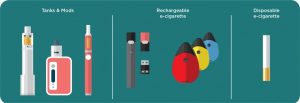This blog is part of a monthly series on health-related topics from a collaboration between Pima County Public Library and Pima County Health Department.
Please note, you can enlarge the images below by clicking on them.
“They’re lying, cheating and fooling people into a lifetime of addiction, disease and death. But we’re not fooled. And we can stop them.” – Take Down Tobacco
We’ve all seen them. Sleek and classy, colorful and flavorful, and often tactfully small and discreet. Somehow, despite the amount of evidence piling to demonstrate how dangerous they are for youth, these products are legally sold in the USA. Youth are still using them too, even though US federal law only allows those aged 21 and up to consume them (FDA, 2024).
The chemical they are selling is nicotine, a highly addictive drug. The products they are selling are vapes, also known as e-cigarettes, mods, or Electronic Nicotine Delivery Systems (ENDS). Infiltrating our school in forms that look like highlighters, USB drives and other school supplies or clothing items, vapes continue to show up in our community in a big way (NIDA)! Although cigarette usage is decreasing in Pima County, especially among younger generations, Big Tobacco companies are using millions of dollars in marketing to hook children to these products at younger ages so that they become lifelong consumers (CDC).
But vapes are approved so they must be okay to use, right? WRONG.
Although more than 6,000 vaping products are available on the market, only 34 products have actually been authorized by the FDA as of January 2025 (CDC, FDA). While there is evidence that vapes may be a healthier option for adults who would like to stop smoking cigarettes (Cochrane), they are not approved by the U.S. Food and Drug Administration (FDA) as a smoking cessation aid (CDC, 2025).
But vapes aren't that harmful to our health, right? WRONG.
Compared to cigarettes, vapes often have a less obvious scent, enticing flavors, cause less irritation when inhaled, all making them seem relatively harmless. However, vape aerosol still contains harmful and potentially dangerous chemicals other than nicotine like heavy metals, formaldehyde, and diacetyl, which is linked to a serious lung disease when inhaled (CDC, FDA). Nicotine itself can increase risk of heart diseases and mental health issues, despite seeming to relieve anxiety (CDC).
One of the biggest threats to our community with vapes is for our children and young adults. For younger brains that are still developing (under 25), vaping can cause mood disorders, impulse control problems, and increase potential for addiction to other drugs by rewiring their brain and harming their brain development (NIDA, CDC). Teens are especially vulnerable due to peer pressure and the false belief that vaping helps with stress and depression, when in reality, it worsens mental health (CDC).
Well, at least I’m not the one smoking or vaping, right? WRONG.
While we may not be the ones consuming the product directly, secondhand smoke and aerosol from vapes still put us at risk (CDC). There is no safe level of exposure to secondhand smoke (CDC). Even being in the same room as someone who has recently used a cigarette or vape can impact us through what is called “third hand smoke/aerosols” that is the residue that remains on the walls, furniture, clothing, and more (ALA). Our pets are even at risk of higher rates of cancer, respiratory problems and other health issues as a result of living with smokers (ALA).
But it’s not happening here, right? WRONG.
In Pima County, about 1 in 20 adolescents reported having ever smoked a cigarette and at least 3 in 20 having used a vape at least once. Rates are highest among female, white and native American youth (Arizona Youth Survey, 2024).
So, what can I do?
- Participate in Take Down Tobacco Day April 1st by wearing black and posting in solidarity against Big Tobacco on social media using the Take Down Tobacco hashtag: #TakeDownTobacco.
- Read books about tobacco (see below) and learn more, share information you’ve learned with your friends and family.
- Talk to your kids about vapes and commercial tobacco products and why they are dangerous. Brainstorm and share ideas on how to avoid peer pressure to use them. Find ways to support young people and other family members towards quitting if you discover they are using these products (ACS).
- Share resources like the quit lines Ashline (1-800-55-66-222) and My Life My Quit (text “Start My Quit” to 36072) to anyone you may know who is already using commercial tobacco products to significantly boost their chances of quitting this highly addictive drug successfully. The health benefits of quitting start within just 20 minutes!
Recommended vaping and tobacco-related books available at the library:
Your Personal Stop Smoking Plan
VAPING 101: A Q&A Guide for Parents - A Doctor's Advice on How to Keep Your Teens Safe from the ...
From Smoking and Vaping To Breathing
This blog post was brought to you by the Tobacco and Chronic Disease Prevention Team at the Pima County Health Department. The program aims to reduce commercial tobacco and vaping use by preventing initiation, promote cessation of commercial tobacco use, promote awareness on the harms of commercial tobacco and exposure to second and third hand smoke and aerosol. The disparities of commercial tobacco use are also an important focus of the team’s efforts.
To learn more visit their website at: Commercial Tobacco Prevention & Cessation | Pima County, AZ
Take Down Tobacco is a national campaign meant to empower young people to fight Big Tobacco. In partnership with the Pima County Superintendent’s Office, the Tobacco and Chronic Disease Prevention program relaunched the Pima County Health Department’s REAL DEAL on Vaping media campaign in support of the ongoing effort to prevent youth nicotine use and addiction and celebrate the Take Down Tobacco National Day of Action on April 1st. Several of the images shared in this blog post are related to these campaigns.






